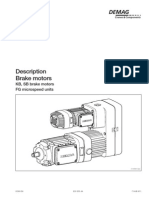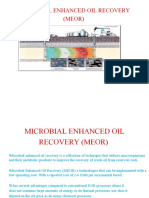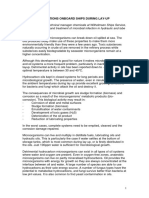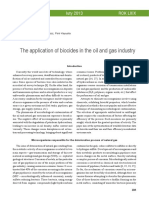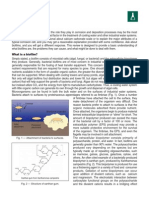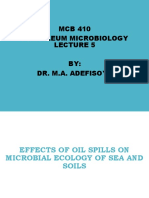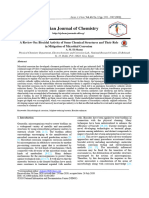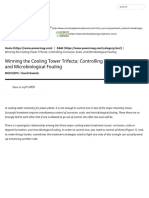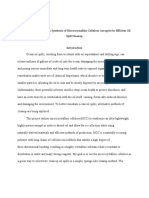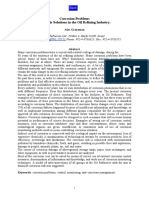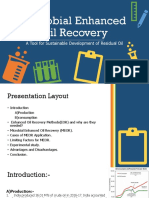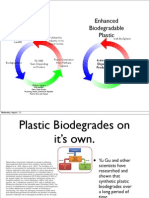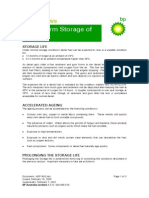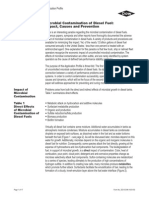Microbial Contamination of Diesel Fuel: Impact, Causes and Prevention
Microbial Contamination of Diesel Fuel: Impact, Causes and Prevention
Uploaded by
Rebecca HartmanCopyright:
Available Formats
Microbial Contamination of Diesel Fuel: Impact, Causes and Prevention
Microbial Contamination of Diesel Fuel: Impact, Causes and Prevention
Uploaded by
Rebecca HartmanOriginal Description:
Original Title
Copyright
Available Formats
Share this document
Did you find this document useful?
Is this content inappropriate?
Copyright:
Available Formats
Microbial Contamination of Diesel Fuel: Impact, Causes and Prevention
Microbial Contamination of Diesel Fuel: Impact, Causes and Prevention
Uploaded by
Rebecca HartmanCopyright:
Available Formats
Application Profile
Microbial Contamination of Diesel Fuel:
Impact, Causes and Prevention
General There is an interesting paradox regarding the microbial contamination of diesel fuels.
Numerous papers, symposia and other reports have thoroughly documented the adverse
impact of microbial contamination in diesel fuels. A variety of products and procedures are
available for minimizing this impact. Yet, of the nearly 12 billion gallons of diesel fuel
consumed annually in the United States,
1
less than one percent is treated with an
antimicrobial agent. One explanation for this paradox is that few truck, ship or railroad fleet
operators recognize the economic impact of uncontrolled microbial contamination. The
effects of microbial contamination are often subtle, and are rarely identified by system
operators as the cause of defined fuel-performance stability problems.
The purpose of this Application Profile is three-fold. The first section will address the impact
of uncontrolled microbial contamination of diesel fuels. Its objective is to show the
connection between a variety of performance problems and microbial growth in diesel
systems. In order to control contamination successfully, operators must understand its
causes and dynamics, which will be the focus of the second section. The remainder of the
paper will address approaches for preventing and curing microbial contamination.
Impact of Problems arise from both the direct and indirect effects of microbial growth in diesel tanks.
Microbial Table 1 summarizes direct effects.
Contamination
Table 1
Metabolic attack on hydrocarbon and additive molecules
Direct Effects
Surfactant metabolite production
of Microbial
Organic acid production
Contamination of
Sulfate reduction/sulfide production
Diesel Fuels
Biomass production
Biofilm formation
Virtually all diesel fuel contains some moisture. Additional water accumulates in tanks as
atmospheric moisture condenses. Moisture accumulates in diesel tanks as condensate
droplets on exposed tank surfaces, as dissolved water in the fuel and as water bottoms
beneath the fuel (Figure 1 - see page 2). As will be discussed later, microbes depend on this
water for growth. Additionally, microbes depend on the organic and inorganic molecules in
diesel fuel for nutrition. Consequently, some species attack the fuel directly, growing at the
expense of hydrocarbons and non-hydrocarbon fuel components. The biodegradation of
fuel, in support of microbial growth, is a direct impact of contamination. Color, heat of
combustion, pour point, cloud point, detergent and anti-corrosive properties change as
microbes selectively attack fuel components. Sulfur-containing molecules are metabolized
by a series of species, leading ultimately to the production of high concentrations of
hydrogen sulfide. In addition to creating new cells, many microbes produce metabolites
which promote further attack. Surfactants facilitate the emulsification of fuel, leading to the
formation of a cloudy, invert-emulsion layer above the fuel:water interface (Figure 2).
Page 1 of 17 Form No. 253-01246-10/01/03
Polysaccharide slimes create microenvironments wherein mixed populations (consortia)
of bacteria and fungi carry out biodegradation reactions that would be impossible for a single
species outside the microenvironment.
2
The slime also serves as a barrier, protecting the
microbes from preservatives. A variety of organic acids (primarily 2 - 4 carbon atoms) are
also produced as by-products of bacterial and fungal growth. As the acids accumulate, they
cause a number of indirect effects. These effects will be considered later in this profile.
Figure 1
Fungal growth at
fuel:water
interface, in a
diesel fuel storage
tank.
Figure 2
Invert emulsion
layer forming in
diesel fuel above
biofilm which is
growing at
diesel:water
interface.
Figure 3
Example of
biomass
accumulation on
fuel tank surfaces.
Table 2
Microbially influenced corrosion
Indirect Effects
Sludge formation
of Microbial
Organic acid accumulation
Contamination of
Hydrogenase-caused depolarization of metallic surfaces
Diesel Fuels
Transfer-line flow restrictions
Filter plugging
Engine wear
Corrosive deposits on engine parts (injectors, cylinder linings, etc.)
Reduced heat of combustion
Page 2 of 17 Form No. 253-01246-10/01/03
Fuel property changes: color, pour point, cloud point, thermal stability
Loss of additive performance
As bacteria and fungi reproduce, they form biomass, which accumulates at the fuel:water
interface, on tank surfaces and on filters (Figure 3). The development of biomass is a direct
consequence of microbial growth. Its effect on fuel systems is mostly indirect.
There are several important indirect effects of biomass and slime production, as
summarized in Table 2. As biomass turns over, and as metabolic waste and dead cells
accumulate, they settle out as sludge which accumulates on tank bottoms (Figures 4a, 4b).
The appearance and composition of this sludge may be quite variable, but the presence of
large numbers of microorganisms is nearly universal. The types of microbes dominating a
particular sludge appear to depend on the physical-chemical conditions of the sludge. The
important issue here is the accumulation of a mass, beneath which microbially influenced
corrosion (MIC), sulfide production and organic acid accumulation occurs.
3,4,5
If sufficient
sludge builds up, sludge particles will be drawn out with the diesel fuel. As a result, filters
and injector orifices may become clogged.
6
More often, filter and line plugging result from biofilm formation on transfer-line walls and
filter-matrix surfaces. The first symptom of this is reduced filter-life. Often, in operations
where chronic microbial contamination goes unrecognized, reduced filter life also goes
unrecognized.
7
Figure 4a
Example of sludge
build-up at the
bottom of a fuel
storage tank.
Figure 4b
Close-up of the
sludge
accumulation
shown in Figure
4a.
Page 3 of 17 Form No. 253-01246-10/01/03
Figure 5a
Example of fuel
filter fouled with
biomass
accumulation;
whole filter.
Figure 5b
Close-up of
biofouled filter
shown in Figure
5a.
It is only after biomass production is inhibited, and the consequent prolongation of filter life
is discovered, that the existence of the previous problem is recognized.
8
Occasionally,
catastrophic failures, like engine shut-down due to fuel starvation, provide convincing
evidence of the importance of contamination control. One of the more sinister aspects of the
filter-plugging problem is that often the biofilm is nearly transparent. Consequently it
generally goes unnoticed. Only rarely does one see the kind of biomass accumulation
illustrated in Figures 5a and 5b.
A secondary, indirect effect of flow restriction is increased engine wear.
9
Non-uniform flow
causes variation in combustion within cylinders. Increased piston and cylinder wear rates
and increased torque on camshafts translate into increased maintenance costs. Engine
failure due to fuel starvation can be a particularly embarrassing consequence of biofilm
accumulation.
If it happens to an aircraft engine during flight, or a marine diesel during operations in
restricted waters or heavy seas, the impact can be catastrophic. As anti-corrosive additives
are biodegraded, and organic acids accumulate in fuel, the probability of corrosion deposits
on pistons, cylinders and injectors increases.
Microenvironments, conducive to MIC, may be produced throughout any storage or service
tank. Volatile organics in the vapor phase above stored fuel are absorbed by condensate
droplets, providing an excellent environment for biofilm formation on exposed tank surfaces.
Small tears or openings in tank surface coatings provide niches for microbes to grow
between the coating and tank surfaces. Further compromise of the coating follows, often
accompanied by MIC of the tank walls. This phenomenon can also occur at the fuel:tank-
surface and the bottoms water:tank-surface interfaces, where dissolved organic molecules
and other nutrients are abundant.
10,11,12
In summary, uncontrolled microbial contamination of diesel fuels has a significant direct
adverse economic impact at every phase of the fuel production, transport, storage and
consumption industries. Degradation of diesel fuel can begin during interim storage at the
refinery. Often, contamination processes which start at this stage go undetected until fleet
operators experience problems. Microbes attack the fuel and additives directly. They also
cause secondary problems, including sludge formation, fouling and corrosion. Tank-farm
maintenance and fleet operations costs can be reduced substantially by controlling
contamination before the problems occur. In the next section, we will review the causes and
dynamics of microbial contamination in fuel systems.
Page 4 of 17 Form No. 253-01246-10/01/03
Microbial To control microbial contamination successfully, an operator must have a clear idea of what
Contamination kinds of microbes contaminate fuel, where they come from, and how and why they grow in
Its Nature fuel systems. While the answers to the what, where, how and why questions are complex,
and Sources it is possible for the field operator and engineer to become sufficiently familiar with the basic
concepts to be able to make sound contamination-control decisions.
Two major groups of microorganisms contaminate fuel systems; bacteria and fungi. Bacteria
are single-cell organisms that lack a membrane-bound nucleus. In contrast, fungi do have a
defined nucleus. The nucleus is the organelle which contains most of the cells genetic
material.
13
Table 3 lists the bacteria and fungi most commonly recovered from diesel fuel and
associated water bottoms. Note that the fungi can be divided into two groups: filamentous
molds and single-cell yeasts. Taxonomic classification does not provide a great deal of
information about what the microbes do. It is important to differentiate between bacteria and
fungi because they are structurally very different, and therefore respond to treatment
differently.
Table 3 Bacteria Fungi
Bacteria and Pseudomonas species
1
Hormoconis resinae
2
Fungi Commonly Flavobacterium species Fusarium species
Recovered from Sarcina species Candida species
Diesel Fuel Desulfovibrio species Aspergillus species
Desulfotomaculum species
Hydrogenomonas species
Clostridium species
Notes: 1) The term species indicates that various species of the genus are routinely recovered.
Notes: 2) Hormoconis is the current name given to the fungus formerly classified as Cladosporium.
An alternative approach to classifying microbes in fuel systems is by their activities or
oxygen requirements. Bacteria that require oxygen are called obligate aerobes. Obligate
aerobes are introduced into fuel systems along with other contaminants, but will die off
unless a minimum concentration of free oxygen is available to them. In contrast, obligate
anaerobes cannot grow in the presence of oxygen. The sulfate-reducing bacteria are
examples of obligate anaerobes. A third group, the facultative anaerobes, thrive in well-
aerated environments (oxic) as well as in oxygen-depleted (anoxic) environments.
Facultative anaerobes play a pivotal role in the contamination story. They consume oxygen
and create environments suitable for the proliferation of obligate anaerobes.
Typically, rather than classifying microbes, the objective is to prevent them from causing a
particular problem or series of problems. In this context, it often makes sense to consider
the activities rather than the individual microorganisms. Hydrocarbon utilization, sulfate
reduction, acid production, surfactant production, slime formation and biomass accumulation
are adverse activities which can be measured. If the operator can be certain that these
activities have been arrested, then further classification of the responsible bacteria and fungi
is almost irrelevant.
Table 4 lists the most common sources of fuel system microbial contaminants. As fuel is
drawn from a tank, air or water is drawn in to compensate for the vacuum which would
otherwise be caused by the removal of the fuel. This is the most common means by which
contaminants are introduced into both bulk storage and service tanks. Bacteria and fungi are
carried through the air either attached to dust particles, entrapped in water droplets, or as
discrete aeroflora.
Page 5 of 17 Form No. 253-01246-10/01/03
Table 4
Vents - Air, Water, Dust
Common Sources
Tank Floating Roofs Leaks
of Microbial
Ballast/Seepage Water
Contamination in
Transfer Piping
Diesel Fuel Fixed Portable
Storage and
Cross-Contamination Between Systems
Day-Tanks
Leakage into Underground Tanks
The second most common source of contamination is portable fuel transfer piping. Dirt,
grime and water accumulate in hoses when they are not in service. This material is often
transferred with the first slug of fuel during operations. In marine operations, fuel tanks are
often seawater ballasted. While seawater displacement is critical for maintaining
seaworthiness of marine craft, it presents a unique problem to fleet operators. Seawater
introduces a variety of organic and inorganic nutrients, in addition to a heavy inoculum of
bacteria and fungi.
Fixed fuel-transfer piping may become contaminated when used to transfer contaminated
fuel into previously uncontaminated tanks or when used for both bottoms-water discharge
and fuel transfer.
Few microbes actually proliferate in fuel itself. All organisms need water to grow. As
mentioned earlier, bacteria and fungi can get the water they need from three sources within
a fuel storage system. Water vapor, and condensate on exposed surfaces, provide certain
fungi and bacteria with all of the moisture they need to colonize tank surfaces. If there is
sufficient dissolved water in the fuel phase, fungi will be able to scavenge what they need,
giving the illusion that they are actually proliferating in fuel. However, growth is generally
most abundant at the fuel:water interface.
Bacteria first colonize the interface, producing surfactants and lipopolysaccharides known as
scinnogens.
14
Membranous scinnogens may act as solid surfactants, facilitating the
assimilation of fuel hydrocarbons by the bacteria which secrete them. A similar phenomenon
occurs at solid:liquid interfaces. Here the lipopolysaccharide matrix is generally referred to
as the glycocalix.
15
As the biofilm matures, diverse bacterial and fungal species establish
themselves in a complex consortium community. The consortium is often able to carry out
biodeterioration processes that would be impossible for individual species. The role of
facultative anaerobes in creating an environment conducive to the growth of obligate
anaerobes has already been discussed.
In addition to creating a suitable microenvironment for long-term growth and survival, the
consortium also processes nutrients. For example, many members of the consortium do not
metabolize hydrocarbons. Those that do, could build up toxic metabolites if other species
werent present to use them as nutrients. Thus a complex food chain accelerates the
biodeterioration of the fuel and additives. The foregoing discussion illustrates why most of
the microbial activity in fuel systems is occurring within the scinnogen or glycocalix matrix.
These films provide a unique environment in which microbes can thrive, almost impervious
to conditions in the bulk fluid. This also explains why microbial analysis of grab samples can
be misleading. Although grab samples are relatively easy to retrieve, typically they fail to
recover biofilm and sludge communities. As will be discussed in the next section, microbe-
free grab samples may give system operators a false sense of security, while biofilm
communities continue to degrade the stored fuel and continue to cause flow restriction and
filter plugging.
Page 6 of 17 Form No. 253-01246-10/01/03
Contamination There are four primary aspects of contamination prevention and control. They are:
Prevention and
Control
Engineering
Monitoring
Maintenance
Treatment
Each aspect contributes to successful minimization of microbial contamination problems,
and consequently to reduction of operating costs attributed to these problems.
Engineering:
Fuel systems can be divided into storage, transfer, purification and delivery/combustion
components. Storage takes place in tanks. Tanks vary in size from 5-gallon portable units to
underground caverns holding several million barrels of distillate fuel.
16
The opportunity for
contamination and the facility with which contaminants are removed are, in large part, a
function of tank design. Small service tanks (day tanks, vehicle tanks, etc.) should be
equipped with a drain-plug at their lowest point. Service tanks should be mounted so that
water and sediment bottoms can be drained off easily. Conical bottom configurations are
advantageous, since they make it easier to concentrate and drain sludge and bottoms water.
Tank vents should be equipped with filters to prevent particles from being drawn in as fuel is
removed (Figure 6).
Figure 6
Schematic drawing
of a typical
distilalte-fuel
storage tank.
Large-tank design should follow the same principles as those recommended for service
tanks. In larger tanks it is even more critical to provide a means for removing water and
sludge from the bottoms at regular intervals. Tanks also need access for periodic inspection
and maintenance. Access-port location options are limited in the cases of shipboard and
underground tanks. Manholes fitted into tank tops should be large enough to permit
personnel and equipment to enter the tank. Access ports for surface tanks should be located
about two feet above the ground. This permits easy entry, but reduces the risk of
contamination due to standing water seepage.
Mild steel and stainless steel are the most common fuel storage tank construction materials.
When interior coatings are used, the materials of choice are polyurethane or two-component
epoxy systems. If coatings are used, uniform coverage and coating integrity are essential.
The problems generated by intrusion of moisture or fuel between the coating and underlying
tank wall have been discussed previously. Interior surfaces should be smooth. Corrosion
cells often start along weld seams and other surface irregularities. Seals and gaskets should
be made of material which is both resistant to the effects of weathering, and chemically
compatible with fuel.
Page 7 of 17 Form No. 253-01246-10/01/03
Pipe fittings should be designed and located with a clear idea of their intended function. To
prevent possible contamination with bottoms water or sludge-dwelling microbes, filler pipes
should not extend more than 3/4 of the depth of the tank from the tank roof. Fuel transfer
piping should not draw from the bottom of tanks. Some storage tanks are fitted with
adjustable-level discharge piping. Theoretically, these can be used to draw fuel from just
above the water:fuel interface (Figure 7). This is meant to facilitate first-in, first-out fuel
transfer. There is risk in potentially drawing off a slug of invert emulsion, biofilm and water,
instead of fuel. Fuel discharge lines should draw fuel from the middle third of the tank
volume, instead. Both fill and discharge line ends should be U configured to reduce the risk
of disturbing the fuel:water boundary layer, and thereby increasing the risk of fuel
contamination. Water and sludge discharge piping should draw from the lowest point in the
tank. Fuel transfer lines should never be used to draw off bottoms.
Figure 7
Flotation system,
supporting
adjustable
discharge piping,
illustrated in
Figure 6. Note
biomass
accumulation on
and beneath floats.
Permanent transfer piping should be clearly marked as to inlet and outlet valves and
orifices. Tanks should be equipped with fittings for attaching fuel purification equipment.
Optimally, each storage facility would have an installed fuel oil purifier. Large-pore screens
(>20mm) and water traps help to reduce the chances of transferring gross contamination
from one tank to another, but they are inadequate for removing microbes from the fuel.
Centrifuge units are well-suited for removing particles, and mixed-media filtration systems
can polish (remove particles and microbial detritus) fuel. Typically, sand or diatomaceous
earth filters precede fiber filters in series (Figure 8). Water traps and fiber filters prevent
entrained water, biomass and other particulates from reaching engines.
Figure 8
Schematic drawing
of a typical,
installed fuel
filtration system.
Well-designed storage, transfer and purification systems reduce the risk of serious microbial
contamination problems. When problems do occur, they can be corrected at substantially
less cost than that required to treat systems in which the aforementioned contamination
Page 8 of 17 Form No. 253-01246-10/01/03
control measures were not incorporated into the system design. By keeping fuel
contamination-free at each stage of the production-to-combustion trail, refinery operators,
distributors and fleet operators all benefit. Good engineering practices make a major
contribution to the effort. However, without well-conceived and properly-executed
monitoring, maintenance and treatment programs, good engineering is of limited value.
Monitoring:
Westbrook and Stavinoha
17
list four objectives of fuel-monitoring programs:
To indicate whether fuel systems are contaminated.
To provide information to facilitate troubleshooting, when necessary.
To determine whether stored fuel has deteriorated beyond acceptable limits.
To provide criteria for scheduling preventive maintenance on fuel and fuel systems,
thereby avoiding unexpected failures during operations.
Monitoring programs consist of four phases:
Sampling
Analysis
Reporting
Interpretation
Sampling procedures are detailed in ASTM D 4057 - 81
18
and D 4177 - 82.
19
The former
standard identifies various types of samples, sampling strategies (location and number of
samples) and sampling devices. It also provides guidance on handling samples to ensure
that subsequent analyses reflect conditions existing in the bulk fluid from which the samples
were drawn.
Although it contains a great deal of useful information, ASTM D 4057 - 81 does not
specifically discuss sampling for microbiological contamination. A paper by Hebda et al.
20
presents a sampling tool for collecting bulk samples from fuel tanks. Hebda recommends
sterilizing the sampler with denatured ethanol when collecting multiple samples in the field.
The experienced sample collector can draw samples from the fuel:water interface, thereby
retrieving biofilm material. This type of sample, comprised of approximately 1/3 fuel and 2/3
water is most useful for examining the extent and impact of microbial contamination at this
critical boundary (Figure 9). Fuel, water and water/sludge samples should also be collected.
Once drawn, samples should be dispensed carefully (to minimize perturbance of the phase
boundaries) into sterile sample bottles. Microbiological samples should always be processed
as soon as possible after sampling, since the number and diversity of bacteria and fungi will
continue to change after collection. Samples should be kept on ice between collection and
analysis, whenever possible. Samples analyzed after 30 hours have little resemblance to
the bulk fluid from which they were drawn.
21
Page 9 of 17 Form No. 253-01246-10/01/03
Figure 9
Typical grab
sample from
fuel:water
interface within a
diesel fuel storage
tank.
Table 5 lists tests commonly run on fuel samples. Standard microbiological test protocols
are detailed in several compendia.
22,23,24
Swift
25
and Hebda et al.
26
provide guidance for
determining microbial contamination levels in distillate fuel and water bottoms.
One test not listed among the ASTM standards, but which should be included among routine
monitoring tests is fuel filterability. A method for determining filterability is suggested by
Creason, et al.
27
Creasons group recommends filtering 500 mL of clean fuel through a
2.1 m, pore-size filter disc as a benchmark. A pressure filtration apparatus is used,
applying a standard pressure (for example, 15 psig). The filtration time is recorded. The
same procedure is used to determine how long it takes for 500 mL of unknown quality fuel to
pass through the filter. The time ratio for unknown:clean fuel filtration is computed. Ratios
significantly greater than 1.0 indicate that fuel degradation is occurring.
Ultimately the selection of tests to run, and the frequency with which they are performed, are
management decisions. Fuel stored in strategic reserves will not be examined as intensely
as fuel in day tanks for aviation applications. System managers, in consultation with industry
experts, must decide which tests will provide the information required to ensure that
customers consistently receive fuel that meets or exceeds their performance requirements.
Once samples are analyzed, the data must be reported. If replicate analyses were
performed, data should be reported at the mean one standard deviation. Data must be
presented in a standard format, using units of measurement that the intended reader will
understand readily. If criteria values have been established, pass/fail notations should
appear next to the reported values. There are a variety of personal and mainframe computer
data base programs available. If possible, such software should be used to develop a
historical data base.
The only justifiable reason for sampling and analyzing fuel is to provide useful system
management information. To be useful in this sense, the data must be interpreted, in order
to determine further action. At the simplest level, if test data are interpreted to indicate that a
fuel shipment does not pass all criteria, the decision may be to reject the shipment.
Interpretation becomes more complex when operators are trying to understand why a large
volume of fuel has deteriorated. In order to select the most appropriate corrective actions,
operators need to be able to diagnose causes accurately. Recently, computer expert-
systems have been developed to facilitate data interpretation.
28
They promise to be easier to
use than older failure-analysis statistical packages, but may also have use-flexibility
limitations. This is an exciting new developmental area, likely to mature over the next five to
ten years.
Page 10 of 17 Form No. 253-01246-10/01/03
Table 5 Sampling
Fuel Tests ASTM D 4057 Standard Practice for Manual Sampling of Petroleum and Petroleum Products
Useful for Tests
Monitoring
ASTM D 2276 Standard Test Method for Particulate Contamination in Aviation Turbine Fuels
Microbial
ASTM D 473 Standard Test Method for Sediment in Crude Oils and Fuel Oils by the Extraction Method
Contamination in
ASTM D 1796 Standard Test Method for Water and Sediment in Fuel Oils by the Centrifuge Method
Diesel Fuels (laboratory procedure)
ASTM D 240 Standard Test Method for Heat of Combustion of Liquid Hydrocarbon Fuels by Bomb
Calorimeter
ASTM D 2382 Standard Test Method for Heat of Combustion of Liquid Hydrocarbon Fuels by Bomb
Calorimeter (high-precision method)
ASTM D 2550 Standard Test Method for Water Separation Characteristics of Aviation Turbine Fuels
ASTM D 3620 Standard Field Test Methods for Water Separation Characteristics of Aviation Turbine Fuels
ASTM D 3948 Standard Test Methods for Determining Water Separation Characteristics of Aviation Turbine
Fuels by Portable Separometer
ASTM D 1094 Standard Test Method for Water Reaction of Aviation Fuels
ASTM D 1744 Standard Test Method for Water in Liquid Petroleum Products by Karl Fischer Reagent
ASTM D 2709 Standard Test Method for Water and Sediment in Distillate Fuels by Centrifuge
ASTM D 3240 Standard Test Method for Undissolved Water in Aviation Turbine Fuels
ASTM D 4176 Standard Test Method for Free Water and Particulate Contamination in Distillate Fuels (Clear
and Bright Pass/Fail Procedures)
ASTM E 1259 Standard Method for Evaluation of Antimicrobials in Distillate Fuels (based on preliminary
screening and compatibility)
APHA 907 Standard Plate Count
Maintenance:
At present, there is a great deal of intuitive knowledge about problem causes and effects.
The role of water and fuel additives in supporting microbial growth was reviewed in a
previous section of this document. Symptoms of microbial contamination have also been
discussed. Armed with this information, system managers and operators are in a good
position to interpret the data they receive. Good maintenance practices are derived from
good data interpretations.
Perhaps the single most effective maintenance practice is to minimize the exposure of
distillate fuel to water. In some systems (for example, seawater-ballasted marine fuel tanks)
this is impractical. However, tank insulation, recycling through water separators, and routine
discharge of water bottoms all minimize water accumulation in surface-vehicle and
stationary fuel-storage tanks. Systems designed for water removal can also be equipped to
remove particulates - including biomass - from bulk fuel.
29
Sludge should also be removed
from tanks regularly.
In addition to processing stored fuel and purging bottoms water and sludge, periodic tank
inspection and cleaning should be scheduled. Periodic treatment with preventive doses of
approved fuel preservatives should prolong the interval between most of these labor-
intensive maintenance activities.
30
The frequency of any maintenance action should be dictated by the data being monitored.
Once a historical record has been developed, advanced maintenance scheduling becomes
easier to accomplish. In the interim, maintenance actions should be triggered by changes in
monitored parameters. Trends, rather than discrete data points, provide better indications for
corrective and preventive actions. For example, if the particulate contamination or filterability
Page 11 of 17 Form No. 253-01246-10/01/03
index increases over three or more successive periodic measurements, the fuel should be
clarified before it fails the quality criteria for these parameters. If experience demonstrates
that the requirement for clarification recurs at predictable intervals, then a schedule for fuel
clarification can be defined.
Treatment:
Despite carefully conceived and executed maintenance programs, stored fuel may still
become heavily contaminated with microbial growth. When this happens, the fuel and water
bottoms must be treated to control the infection and to remove biomass from the system.
Routine treatment, as discussed under Maintenance, has proven to be an effective means of
dramatically reducing the risk of catastrophic contamination events.
31
In this context, treatment refers to both chemical addition and mechanical processing of the
contaminated fuel and associated water bottoms and sludge. The mechanical phase of the
treatment process is similar to that described under Maintenance. To be most effective,
microbicide is metered into the fuel at the discharge end of the clarification unit, as the
dewatered, clarified fuel is pumped into a clean storage tank. Before being used again,
contaminated tanks should be cleaned thoroughly. All residual material (wall and overhead
slime, bottoms sludge) should be removed. Tank interiors and internal pipe fittings should be
inspected for corrosion and proper function. Waste material generated during the clean-up
process is considered hazardous, and should be hauled-off only by companies certified as
hazardous waste handlers.
The importance of combining mechanical treatment with chemical treatment cannot be over-
stressed. Biocides used to treat contaminated fuel may never come into contact with
microbes imbedded deep within scinnogen, sludge and biofilm layers. Since biocides are
consumed as they kill microbes, survivors will flourish as soon as biocide concentrations
decrease to sub-toxic levels. In fact, sub-toxic concentrations of biocide may stimulate
growth! Moreover, after a kill, the particle count will increase dramatically for a short period.
Unless this dead-biomass particulate material is removed, the treated fuel may not pass test
criteria for particulates. Consequently, heavily-contaminated fuel systems must be cleaned
mechanically in addition to being treated with an approved biocide.
A number of authors have documented the factors to be considered in evaluating biocides to
be used as fuel disinfectants and preservatives.
32,33,34
Key considerations include:
Water/fuel solubility
Speed of kill
Persistence of effect
Compatibility with fuel and other additives
Compatibility with other system components
Handling and disposal safety considerations
Industry and regulatory approvals
To select the best biocide for a particular fuel treatment, the operator must first define the
objectives of the treatment program. If the objective is to control microbial growth in water
bottoms, a water-soluble biocide would probably be the best choice. If the system is water-
free, then a fuel-soluble product would be entirely satisfactory. In most cases, the
requirement is to preserve fuel by inhibiting the attack for microbes at the fuel:water
interface. This means that biocides which partition into both the fuel and water phases will
most often provide the most satisfactory results.
35,36
Page 12 of 17 Form No. 253-01246-10/01/03
Biocides serve two functions. As shock-treatments, they are intended to kill existing
microbial contaminants within a few hours. Realistically, shock-treatment should achieve
>99 percent kill within eight hours after dosing. The actual time required to realize this kill
depends as much on mixing as it does on biocide product selection. To be effective, the
biocide must be distributed uniformly throughout the contaminated system.
This is the rationale for metering product into the system at the discharge end of the
clarification unit. Adding biocide at this stage also eliminates the requirement to treat the
water and sludge phases which are to be removed from the system anyway. The
consequence is improved treatment efficacy and cost-effectiveness. Heavily contaminated
systems require higher biocide doses than do mildly contaminated systems. Operators
should follow biocide manufacturers recommendations regarding appropriate dosing
practices.
Persistence of effect is a critical criterion for selecting a microbicide intended for preventive
treatment. Optimally, a product which resides primarily in the fuel phase, but partitions into
the aqueous phase to control growth at the fuel:water interface, should be selected. This
type of biocide will be more likely to persist in sufficient concentration to inhibit microbial
growth for several months. Water-soluble biocides are unsuitable unless system managers
intend to keep the water bottoms in their tanks indefinitely, since water-soluble biocides are
carried off with bottoms waters as they are discharged. Since microorganisms do not tend to
proliferate in the fuel phase,
37
fuel-soluble biocides that are not also at least partially water-
soluble seem to be of limited value. Biocides are evaluated in laboratory tests which are
intended to simulate field conditions.
38,39
Products which suppress microbial growth for at
least eight weeks should provide satisfactory field service. Greater than 99 percent growth
inhibition in treated test systems, relative to untreated controls, meets the criterion for
suppression.
In addition to being effective, biocides must be compatible with fuel and fuel-system
components. The selected antimicrobial should not affect fuel stability, performance or
appearance adversely. Compatibility tests should be run concomitantly with efficacy tests.
The tests listed in Table 5 can be used for this purpose. Specific industries may require
additional compatibility testing to ensure that fuel additives do not affect fuel system
components adversely. Aviation and land-based gas turbine system manufacturers require
extensive compatibility testing
40,41
before approving fuel additives.
Biocide manufacturers provide instructions for the safe handling and disposal of their
products. As antimicrobials, these products are, by definition, toxic. So are a variety of
regularly-used household products (chlorine bleach, ammonia, caustic drain cleaners, etc.).
When used as instructed, biocides represent no more risk than do the aforementioned
household products. Personnel handling biocide concentrates should wear appropriate
protective clothing (rubber apron, gloves and goggles). These are the same precautions
recommended for handling most industrial chemicals. Only biocides registered as fuel
preservatives or disinfectants with the appropriate governmental agency (U.S. EPA in the
United States) should be considered for use.
Once a biocide has been selected, there are several application strategies that can be
implemented. The two broadest categories, noted earlier, are shock treatment against an
existing heavy contaminant population, and preventive treatment. Within each of these
categories there are alternative biocide addition routines. The most cost-effective strategy is
to treat stored fuel periodically with maintenance doses of biocide. Frequency and
concentration are based on the manufacturers recommendations, and field monitoring data.
Page 13 of 17 Form No. 253-01246-10/01/03
Tankage at each echelon of the distribution process should be treated. Even motor-vehicle
and ships tanks should be treated to minimize the rate of sludge accumulating and the
effect of microbial growth in bottoms water.
Conclusions Despite growing evidence of the significant adverse economic impact of microbial
contamination on diesel and gas turbine engine operations, only a few operators treat their
fuel with antimicrobials. One reason for this is the subtle nature of microbial contamination,
which goes undetected until catastrophic failure takes place. Fuel performance, system
integrity, filter life and engine life can be degraded significantly by the direct and indirect
effects of microbial activity. Consequently, treatment with a fuel preservative can have a
positive economic impact on bottom-line operational costs.
This Application Profile has documented the effects of uncontrolled microbial growth, and
has explained where and how that growth occurs in fuel systems. Approaches for minimizing
contamination problems through system design, monitoring, maintenance and treatment
programs have also been reviewed.
Product Dow encourages its customers to review their applications of Dow products from the
Stewardship standpoint of human health and environmental safety. To help ensure that Dow products are
not used in ways for which they are not intended or tested, Dow personnel are willing to
assist customers in dealing with ecological and product safety considerations. Dow
literature, including Safety Data Sheets, should be consulted prior to use of Dow products.
Contact your Dow representative if you need any assistance or information.
References 1. Anonymous. 1989. Petroleum and Natural Gas, Sec. 229.3001 Chemical Economics
Handbook. SRI International, Menlo Park, CA.
2. Shennan, J.L. 1988. Control of Microbial Contamination of Fuels in Storage. In
Biodeterioration 7. Ed. D.R. Houghton, R.N. Smith and H.O.W. Eggins. Elsevier, London.
pp. 248 - 255.
3. Booth, G.H. and F. Wormwell. 1962. Corrosion of Mild Steel by Sulphate-Reducing
Bacteria. Effect of Different Strains of Organisms. First Internat. Cong. Metal. Corr.
Butterworths, London. pp. 341 - 354.
4. Staffeldt, E.D. and O.H. Calderon. 1967. Possible Degradation of Metals by
Microorganisms. Devel. Ind. Microbiol. 8: 321 - 334.
5. Tiller, A.K. 1988. Some Case Histories of Corrosion Failures Induced by Bacteria.
Internat. Biodeterior. 24: 231 - 237.
6. Neihof, R. and M. May. 1983. Microbial and Particulate Contamination in Fuel Tanks on
Naval Ships. Internal. Biodeterior. Bull. 19: 59 - 68.
7. Pickering, T.H., Jr. 1988. Fuel Quality Program for Long-term Storage of Gas Turbine
Distillate Fuel in Large Tanks. In Distillate Fuel: Contamination, Storage, and Handling
ASTM STP 1005. H.L. Chesneau and M.M. Dorris, Eds. American Society for Testing and
Materials, Philadelphia, PA. pp. 167 - 182.
8. Francis, D.E., II. 1988. Effects of Unstable and Microbially Contaminated Fuel on Vehicle
Operations: A Diesel Fuel Preventive Maintenance Program. In Distillate Fuel:
Contamination, Storage and Handling, ASTM STP 1005. H.L. Chesneau and M.M. Dorris,
Eds. American Society for Testing and Materials, Philadelphia, PA. pp. 157 - 166.
Page 14 of 17 Form No. 253-01246-10/01/03
9. Halsall, R. 1988. Effects of an Unstable Diesel Fuel on Injector Coking and Vehicle
Performance. In Distillate Fuel: Contamination, Storage and Handling, ASTM STP 1005.
H.L. Chesneau and M.M. Dorris, Eds. American Society for Testing and Materials,
Philadelphia, PA. pp. 63 - 81.
10. Klemme, D. E. and R.A. Neihof. 1969. Control of Marine Sulfate-Reducing Bacteria in
Water-Displaced Shipboard Fuel Storage Tanks. Naval Research Laboratory,
Washington, D.C. AD699 885. 22 pp.
11. Hill, E.C. 1981. Microbial Degradation of Lubricants Fuels and Cargoes in Ships. 4th
Malaysian Microbiology Symposium, 17-19 Aug 1981 - Universiti Kegangsaan Malaysia.
12. Sanders, P.F. and W.A. Hamilton. 1986. Biological and Corrosion Activities of Sulfate-
Reducing Bacteria in Industrial Process Plant. In Proceedings of the Internat. Conf. on
Biologically Induced Corrosion (NACE-8). Ed. S.D. Dexter. Nat. Assoc. Corr. Eng.,
Houston. pp. 47 - 68.
13. Stanier, R.Y., E.A. Adelberg and J. Ingram. 1976. The Microbial World. Prentice-Hall,
Englewood Cliffs. 871 pp.
14. Smith, R.N. 1988. Bacterial Extracellular Polymers: a Major Cause of Spoilage in Middle
Distillate Fuels. In Biodeterioration. 7. Ed. D.R. Houghton, R.N. Smith and H.W.O.
Eggins. Elsevier, London. pp. 256 - 262.
15. Characklis, W.G. and K.E. Cooksey. 1983. Biofilms and Microbial Fouling. Adv. Appl.
Microbiol. 29:91 - 138.
16. Roffey, R., A. Norqvist and A. Edlund. 1986. Biodeterioration of Jet Fuel During Long-
term Storage in Rock Caverns. In Biodeterioration 6. S. Barry and D.R. Houghton, Eds.
C.A.B. International, Farnham House, U.K. pp. 476 - 482.
17. Westbrook, S.R. and L.L. Stavinoha. 1988. Storage and Handling of Fuel for Standby
Diesel Generator Systems; A Guide for Nuclear Power Plant Maintenance Personnel.
Electric Power Research Institute, Palo Alto, CA. 58 pp.
18. ASTM. 1981. Standard Practice for Manual Sampling of Petroleum and Petroleum
Products ASTM D 4057 - 81. Annual Book of ASTM Standards; Vol. 5.03: Petroleum
Products and Lubricants (III). American Society for Testing and Materials, Philadelphia, PA.
19. ASTM. 1982. Standard Method for Automatic Sampling of Petroleum and Petroleum
Products ASTM D 4177 - 82. Annual Book of ASTM Standards; Vol. 5.03: Petroleum
Products, Lubricants and Fossil Fuels. American Society for Testing and Materials,
Philadelphia, PA.
20. Hebda, A.J., R.M. Morchat, R.G. Brown and G.M. Jones. 1988. Microbiological
Contamination: Evaluation of Some Sampling and Laboratory Analytical Methods.
In Distillate Fuel: Contamination, Storage and Handling, ASTM STP 1005. H.L.
Chesneau and M.M. Dorris, Eds. American Society for Testing and Materials,
Philadelphia, PA. pp. 27 - 36.
21. Bordner, R. and J. Winter, Eds. 1978. Microbiological Methods for Monitoring the
Environment. EPA-600/8-78-017. National Technical Information Service, Springfield,
VA. 338 pp.
22. Gerhardt, P. 1981. Manual of Methods for General Bacteriology. American Society for
Microbiology, Washington, D.C. 524 pp.
Page 15 of 17 Form No. 253-01246-10/01/03
23. APHA. 1989. Standard Methods for the Examination of Water and Wastewater, 17th
Edition. American Public Health Association, Washington, D.C. 1268 pp.
24. ASTM. 1987 ASTM Standards on Materials and Environmental Microbiology. American
Society for Testing and Materials, Philadelphia, PA. 306 pp.
25. Swift, S.T. 1988. Identification and Control of Microbial Growth in Fuel Handling
Systems. In Fuel Contamination, Storage and Handling, ASTM STP 1005. H.L.
Chesneau and M.M. Dorris, Eds. American Society for Testing and Materials,
Philadelphia, PA. pp. 15 - 26.
26. Hebda, A.J., R.M. Morchat, R.G. Brown and G.M. Jones. 1988. op. cit.
27. Creason, A., Q.A. Miller, P. Keller and W.E. Foster. 1973. Filterability Ration Test.
Technical Report, MFA Oil Co., Columbia, MO., presented to the American Petroleum
Institute Forum, February 22.
28. Fass, R. In Press. Computer Expert System for Diagnosis and Control of Microbial
Contamination Level of Distillate Fuels in Storage. In H.W. Rossmoore, Ed.
Proceedings of the Eighth International Biodegradation and Biodeterioration
Symposium. Elsevier, London.
29. Melton, P.M., L.S. McGaughey and A.M. Goldwire. 1988. Method of Managing Long-
term Diesel Fuel Integrity. In Distillate Fuel: Contamination, Storage, and Handling.
H.W. Chesneau and M.M. Dorris, Eds. American Society for Testing and Materials,
Philadelphia, PA. pp. 119 - 138.
30. U.S. Army. 1987. Special Bulletin: Diesel Fuel Stability and Cleanliness Problems in the
Field. U.S. Army Belvoir Research, Development & Engineering Center, Fort Belvoir,
VA. 9 pp.
31. Pickering, T.H., Jr. 1988. op. cit.
32. Rogers, M.R. and A.M. Kaplan. 1968. Screening of Prospective Biocides for
Hydrocarbon Fuels. Dev. Ind. Microbiol. 9:448 - 476.
33. Rossmoore, H.W., J.W. Wireman, L.A. Rossmoore and V.F. Riha. 1988. Factors to
Consider in Testing Biocides for Distillate Fuels. In Distillate Fuel: Contamination,
Storage and Handling, ASTM STP 1005. H.L. Chesneau and M.M. Dorris, Eds.
American Society for Testing and Materials, Philadelphia. PA. pp. 95 - 104.
34. Shennan, J.L. 1988. op. cit.
35. Coutts, A. 1988. Biocide Oil/Water Partition Coefficients: An Important Consideration
when Choosing an Effective Antimicrobial Treatment for Stored Fuel. Petroleum Rev.
(October): 31 - 32.
36. Klein, F.T. 1988. Studies on a U.S. Military Approved Fuel Preservative and Stabilizer.
Presented at the Third International Conference on Stability and Handling of Liquid
Fuels, London, U.K. September 13 - 16.
37. Hill, E.C. 1987. Treatment Strategies. In Microbiology of Fuels. R.N. Smith, Ed.
The Institute of Petroleum, London, U.K. pp. 55 - 61.
38. Rossmoore, H.W., et al. 1988. op. cit.
Page 16 of 17 Form No. 253-01246-10/01/03
39. ASTM. 1988. The Standard Test Method for Evaluation of Antimicrobials in Distillate
Fuel (based on preliminary screening and compatibility), ASTM E 1259 - 88. Annual
Book of ASTM Standards. American Society for Testing and Materials, Philadelphia, PA.
40. ASTM. 1985. Standard Specification for Aviation Turbine Fuels ASTM D 1655-85.
Annual Book of ASTM Standards; Vol. 5.03: Petroleum Products and Lubricants (I).
American Society for Testing and Materials, Philadelphia, PA.
41. ASTM. 1987. Standard Practices for Evaluating the Compatibility of Additives with
Aviation-Turbine Fuels and Aircraft Fuel System Materials ASTM D 4054-81. Annual
Book of ASTM Standards; Vol. 5.03: Petroleum Products and Lubricants (III). American
Society for Testing and Materials, Philadelphia, PA.
Photographs courtesy of Fuel Quality Services, Buford, GA
Page 17 of 17
For further information visit our website:
www.dowbiocides.com or call
United States 1-800-447-4369 (phone)
and Canada: 1-989-832-1560 (phone)
1-989-832-1465 (fax)
Europe: 800-3-694-6367 (phone)
32-3-450-2240 (phone)
32-3-450-2815 (fax)
Pacific: 603-7958-3392 (phone)
603-7958-5598 (fax)
Latin America: 55-11-5188-9555 (phone)
55-11-5188-9937 (fax)
Other Global 1-989-832-1560 (phone)
Areas: 1-989-832-1465 (fax)
NOTICE: No freedom from any patent owned by Seller or others is to be inferred. Because use conditions and applicable laws
may differ from one location to another and may change with time, Customer is responsible for determining whether products
and the information in this document are appropriate for Customers use and for ensuring that Customers workplace and
disposal practices are in compliance with applicable laws and other governmental enactments. Seller assumes no obligation or
liability for the information in this document. NO WARRANTIES ARE GIVEN; ALL IMPLIED WARRANTIES OF
MERCHANTABILITY OR FITNESS FOR A PARTICULAR PURPOSE ARE EXPRESSLY EXCLUDED.
*Trademark of The Dow Chemical Company Form No. 253-01246-10/01/03
You might also like
- DOWfuel - Training (Fuel Contamination)No ratings yetDOWfuel - Training (Fuel Contamination)17 pages
- Biocides Are Products With A Large Range of Components and Chemical StructuresNo ratings yetBiocides Are Products With A Large Range of Components and Chemical Structures3 pages
- Microorganisms in Diesel and in Biodiesel FuelNo ratings yetMicroorganisms in Diesel and in Biodiesel Fuel5 pages
- Microbial Infections Onboard Ships During Lay-UpNo ratings yetMicrobial Infections Onboard Ships During Lay-Up4 pages
- Effect of Biodiesel Concentration On Corrosion of Carbon Steel by Serratia MarcescensNo ratings yetEffect of Biodiesel Concentration On Corrosion of Carbon Steel by Serratia Marcescens7 pages
- Microbial Enhanced Oil Recovery (MEOR) : Lewis R BrownNo ratings yetMicrobial Enhanced Oil Recovery (MEOR) : Lewis R Brown5 pages
- Membrane_Bioreactor_MBR_Technology_for_WNo ratings yetMembrane_Bioreactor_MBR_Technology_for_W10 pages
- Petroleum Microbiology Lecture 5 Oil Spill100% (1)Petroleum Microbiology Lecture 5 Oil Spill49 pages
- A Review of The Mechanism of Microbial Degradation of Petroleum PollutionNo ratings yetA Review of The Mechanism of Microbial Degradation of Petroleum Pollution5 pages
- EJCHEM Volume 63 Issue 12 Page 5251 5267No ratings yetEJCHEM Volume 63 Issue 12 Page 5251 526717 pages
- Materials Corrosion - 2023 - Bairi - Microbially induced corrosion issues in the underground buried crude oil and naturalNo ratings yetMaterials Corrosion - 2023 - Bairi - Microbially induced corrosion issues in the underground buried crude oil and natural15 pages
- Application of Biofilm Technology in Wastewater Treatment: A Critique PaperNo ratings yetApplication of Biofilm Technology in Wastewater Treatment: A Critique Paper3 pages
- Winning The Cooling Tower Trifecta - Controlling Corrosion, Scale, and Microbiological FoulingNo ratings yetWinning The Cooling Tower Trifecta - Controlling Corrosion, Scale, and Microbiological Fouling10 pages
- MEOR Mechanism: Reduction of Oil-Water Interfacial TensionNo ratings yetMEOR Mechanism: Reduction of Oil-Water Interfacial Tension4 pages
- Fuel System Contamination Affecting Injection Diesel Engines AMM.817.27-1No ratings yetFuel System Contamination Affecting Injection Diesel Engines AMM.817.27-18 pages
- Microcrystalline Cellulose Aerogels For Oil Spill RemediationNo ratings yetMicrocrystalline Cellulose Aerogels For Oil Spill Remediation29 pages
- Republic of The Philippines Batangas State University: Pablo Borbon Main I Batangas CityNo ratings yetRepublic of The Philippines Batangas State University: Pablo Borbon Main I Batangas City4 pages
- Influence of Chosen Parameters of Water Fuel Microemulsion On Combustion Processes, Emission Level of Nitrogen Oxides and Fuel Consumption of Ci EngineNo ratings yetInfluence of Chosen Parameters of Water Fuel Microemulsion On Combustion Processes, Emission Level of Nitrogen Oxides and Fuel Consumption of Ci Engine8 pages
- F 2020 C F S: Iltration at Ines OlutionsNo ratings yetF 2020 C F S: Iltration at Ines Olutions11 pages
- GF01-V5 - Microbial Growth Control GuidelineNo ratings yetGF01-V5 - Microbial Growth Control Guideline5 pages
- Effective Varnish Removal From Turbine Lubrication SystemsNo ratings yetEffective Varnish Removal From Turbine Lubrication Systems9 pages
- Bioremediation: Cost-Effective Alternative To Clean Environmental MessesNo ratings yetBioremediation: Cost-Effective Alternative To Clean Environmental Messes4 pages
- Chemicals and Pharmaceuticals Manufacturing Waste WaterNo ratings yetChemicals and Pharmaceuticals Manufacturing Waste Water4 pages
- Microbial Degradation of Lubricating Oils OnboardNo ratings yetMicrobial Degradation of Lubricating Oils Onboard5 pages
- Corrosion Problems and Their Solutions in The Oil Refining IndustryNo ratings yetCorrosion Problems and Their Solutions in The Oil Refining Industry9 pages
- Maria C. F. C. Miranda: Study On Causes and Effects of Corrosion in Petroleum PipelinesNo ratings yetMaria C. F. C. Miranda: Study On Causes and Effects of Corrosion in Petroleum Pipelines7 pages
- Biodegradable Plastic Enhancing Energy Generation100% (1)Biodegradable Plastic Enhancing Energy Generation7 pages
- Investigation of The Activity of Acinetobacter Calcoaceticus Biodemulsifier To Break Stable Water in Oil EmulsionsNo ratings yetInvestigation of The Activity of Acinetobacter Calcoaceticus Biodemulsifier To Break Stable Water in Oil Emulsions7 pages
- BTI Guide To MIC in Fire Protec - Systems 2005No ratings yetBTI Guide To MIC in Fire Protec - Systems 200511 pages
- Omar Elwakil Assignment (Environmental)No ratings yetOmar Elwakil Assignment (Environmental)20 pages
- Water For Injection Prepared by Reverse OsmosisNo ratings yetWater For Injection Prepared by Reverse Osmosis2 pages
- Biological Sludge Minimization and Biomaterials/Bioenergy Recovery TechnologiesFrom EverandBiological Sludge Minimization and Biomaterials/Bioenergy Recovery TechnologiesEtienne PaulNo ratings yet
- Sustainable Catalysis: Challenges and Practices for the Pharmaceutical and Fine Chemical IndustriesFrom EverandSustainable Catalysis: Challenges and Practices for the Pharmaceutical and Fine Chemical IndustriesNo ratings yet
- Green Chemistry for Dyes Removal from Waste Water: Research Trends and ApplicationsFrom EverandGreen Chemistry for Dyes Removal from Waste Water: Research Trends and ApplicationsNo ratings yet
- Changing Diesel Fuel Properties Using AdditivesNo ratings yetChanging Diesel Fuel Properties Using Additives2 pages
- Microbial Contamination of Diesel Fuel: Impact, Causes and PreventionNo ratings yetMicrobial Contamination of Diesel Fuel: Impact, Causes and Prevention17 pages
- Biocides Are Products With A Large Range of Components and Chemical StructuresBiocides Are Products With A Large Range of Components and Chemical Structures
- Effect of Biodiesel Concentration On Corrosion of Carbon Steel by Serratia MarcescensEffect of Biodiesel Concentration On Corrosion of Carbon Steel by Serratia Marcescens
- Microbial Enhanced Oil Recovery (MEOR) : Lewis R BrownMicrobial Enhanced Oil Recovery (MEOR) : Lewis R Brown
- A Review of The Mechanism of Microbial Degradation of Petroleum PollutionA Review of The Mechanism of Microbial Degradation of Petroleum Pollution
- Materials Corrosion - 2023 - Bairi - Microbially induced corrosion issues in the underground buried crude oil and naturalMaterials Corrosion - 2023 - Bairi - Microbially induced corrosion issues in the underground buried crude oil and natural
- Application of Biofilm Technology in Wastewater Treatment: A Critique PaperApplication of Biofilm Technology in Wastewater Treatment: A Critique Paper
- Winning The Cooling Tower Trifecta - Controlling Corrosion, Scale, and Microbiological FoulingWinning The Cooling Tower Trifecta - Controlling Corrosion, Scale, and Microbiological Fouling
- MEOR Mechanism: Reduction of Oil-Water Interfacial TensionMEOR Mechanism: Reduction of Oil-Water Interfacial Tension
- Fuel System Contamination Affecting Injection Diesel Engines AMM.817.27-1Fuel System Contamination Affecting Injection Diesel Engines AMM.817.27-1
- Microcrystalline Cellulose Aerogels For Oil Spill RemediationMicrocrystalline Cellulose Aerogels For Oil Spill Remediation
- Republic of The Philippines Batangas State University: Pablo Borbon Main I Batangas CityRepublic of The Philippines Batangas State University: Pablo Borbon Main I Batangas City
- Influence of Chosen Parameters of Water Fuel Microemulsion On Combustion Processes, Emission Level of Nitrogen Oxides and Fuel Consumption of Ci EngineInfluence of Chosen Parameters of Water Fuel Microemulsion On Combustion Processes, Emission Level of Nitrogen Oxides and Fuel Consumption of Ci Engine
- Effective Varnish Removal From Turbine Lubrication SystemsEffective Varnish Removal From Turbine Lubrication Systems
- Bioremediation: Cost-Effective Alternative To Clean Environmental MessesBioremediation: Cost-Effective Alternative To Clean Environmental Messes
- Chemicals and Pharmaceuticals Manufacturing Waste WaterChemicals and Pharmaceuticals Manufacturing Waste Water
- Corrosion Problems and Their Solutions in The Oil Refining IndustryCorrosion Problems and Their Solutions in The Oil Refining Industry
- Maria C. F. C. Miranda: Study On Causes and Effects of Corrosion in Petroleum PipelinesMaria C. F. C. Miranda: Study On Causes and Effects of Corrosion in Petroleum Pipelines
- Investigation of The Activity of Acinetobacter Calcoaceticus Biodemulsifier To Break Stable Water in Oil EmulsionsInvestigation of The Activity of Acinetobacter Calcoaceticus Biodemulsifier To Break Stable Water in Oil Emulsions
- Biological Sludge Minimization and Biomaterials/Bioenergy Recovery TechnologiesFrom EverandBiological Sludge Minimization and Biomaterials/Bioenergy Recovery Technologies
- Sustainable Catalysis: Challenges and Practices for the Pharmaceutical and Fine Chemical IndustriesFrom EverandSustainable Catalysis: Challenges and Practices for the Pharmaceutical and Fine Chemical Industries
- Green Chemistry for Dyes Removal from Waste Water: Research Trends and ApplicationsFrom EverandGreen Chemistry for Dyes Removal from Waste Water: Research Trends and Applications
- Bioremediation of Petroleum and Petroleum ProductsFrom EverandBioremediation of Petroleum and Petroleum Products
- Microbial Contamination of Diesel Fuel: Impact, Causes and PreventionMicrobial Contamination of Diesel Fuel: Impact, Causes and Prevention
